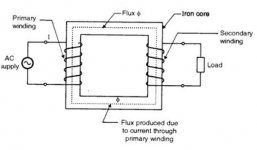wwhitney
Senior Member
- Location
- Berkeley, CA
- Occupation
- Retired
I'm missing some understanding of the details of how an idealized transformer works. Say you have a simple transformer such as shown below, and everything is linear and idealized. Say the AC supply is a fixed voltage source VP(t) = V0 cos(ωt). Then I'm interested in the voltage and current on the primary and secondary, as well as the magnetic flux, as functions of time: VS(t), IP(t), IS(t), and Φ(t). In particular their phase shifts, and whether the magnetic flux varies spatially.
So to build up to the operating state, I'd like to consider state A, where the secondary coil and load are absent; state B where the secondary coil is present but open current; and state C, the operating state.
For state A, this is just an inductor. Faraday's law says VP = NP dΦ/dt, where N is the number of turns of the coil. Integrating gives Φ(t) = V0/(NPω) sin(ωt). For an inductor with inductance L, I = N/L Φ, so IP(t) = V0/(Lω) sin(ωt). As expected, current lags voltage by 90 degrees. [Hopefully I got the details right.]
For state B, is this just the same as state A, but now you get an induced voltage across the secondary coil? If Φ(t) is unchanged, then VS(t) = NS dΦ/dt = NS/NP VP(t), as expected.
Then for state C, current flows in the secondary. Say the load is resistive, then IS(t) will be proportional to VS(t), i.e. in phase. Does the current in the secondary induce a counter magnetic flux, causing Φ(t) and the primary side behavior to change? Because I don't think that VP and IP are still 90 degrees apart.
Thanks,
Wayne
 [/sub]
[/sub]
So to build up to the operating state, I'd like to consider state A, where the secondary coil and load are absent; state B where the secondary coil is present but open current; and state C, the operating state.
For state A, this is just an inductor. Faraday's law says VP = NP dΦ/dt, where N is the number of turns of the coil. Integrating gives Φ(t) = V0/(NPω) sin(ωt). For an inductor with inductance L, I = N/L Φ, so IP(t) = V0/(Lω) sin(ωt). As expected, current lags voltage by 90 degrees. [Hopefully I got the details right.]
For state B, is this just the same as state A, but now you get an induced voltage across the secondary coil? If Φ(t) is unchanged, then VS(t) = NS dΦ/dt = NS/NP VP(t), as expected.
Then for state C, current flows in the secondary. Say the load is resistive, then IS(t) will be proportional to VS(t), i.e. in phase. Does the current in the secondary induce a counter magnetic flux, causing Φ(t) and the primary side behavior to change? Because I don't think that VP and IP are still 90 degrees apart.
Thanks,
Wayne
 [/sub]
[/sub]